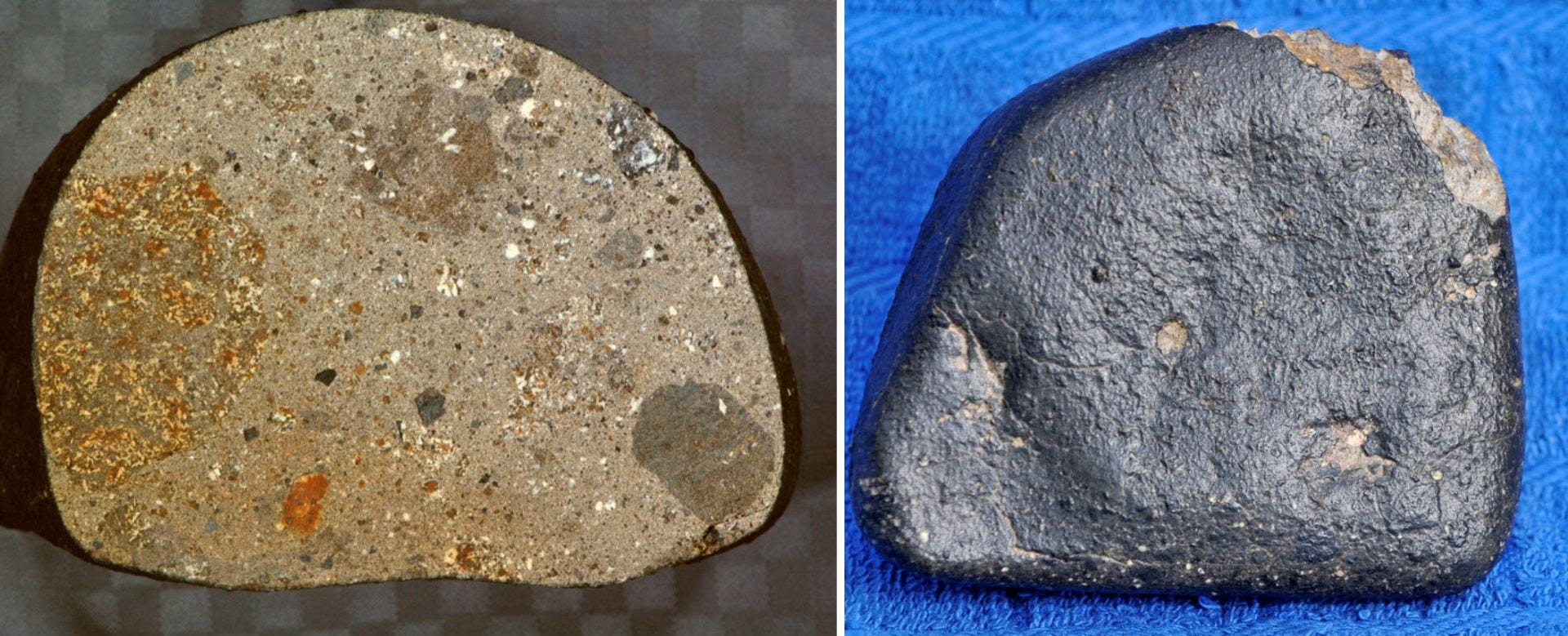Planetary impact breccias
Lunar impact breccias
During the impact of a meteorite, old rocks are broken apart and new rocks are formed. Most lunar meteorites, many HED meteorites (howardites, eucrites, and diogenites), one martian meteorite, and some chondrites are breccias – rocks composed of fragments of older rocks that have been broken apart and relithified (“glued” back together), often many times, by impacts of meteorites. Impact brecciation results in rock that consists of clasts (rock fragments) of a range of sizes imbedded in a matrix of smaller clasts, crystallized impact melt, or glass.

In school, we learn that there are three kinds of rocks – sedimentary, metamorphic, and igneous. An impact breccia can be any of the three but the distinction among them is sometimes difficult to determine. Some impact breccias are sedimentary rocks in that they are fine-grained, near-surface material (regolith) that was consolidated (“glued together”) into a coherent rock by the heat and shock pressure of an impact. NWA 12604 (below) is such a rock, a regolith breccia. A few lunar and HED breccias are metamorphic in that they formed from fragmental material, perhaps several kilometers deep. A large impact occurred that was not close enough (laterally or vertically) to melt the material but was close enough to “cook” and recrystallize the minerals (thermal metamorphism). NWA 3163 and NWA 8687 (below) are metamorphic breccias, which are usually termed granulitic breccias because of their sugar-crystal like texture. Finally, meteorite impacts will melt target material below the point of impact. Some of the liquid will pool in the crater while the rest is ejected to form an ejecta deposit. The chaotic turbulence during and after the impact causes hot impact melt to mix with cold rock clasts. The clasts cool the melt and the melt heats the clasts sometimes to the point where the exteriors melt. This is the only mechanism of which I am aware that can lead to rare, rounded clasts in lunar impact breccias. Liquid impact melt that forms in small craters cools quickly to form glassy-matrix breccias. Crystalline-matrix breccias form in large craters and basins where the melt cools slow enough to crystallize. Both kinds of breccias are igneous in that they cooled and solidified from a liquid. Dhofar 1085, Dhofar 1443, and Shişr 166 (below) are clast-laden, impact-melt breccias. Veins of liquid impact melt injected into the space between rock fragments during an impact, which cool quickly to glass, are common in lunar breccias as are vesicles (gas bubbles) that get trapped in impact glass before it solidifies.

Nonlunar meteorite breccias
Some chondrites are regolith and impact-melt breccias. (I do not study chondrites, so I do not have photos.) Below are photos of a few HED (howardite, eucrite, diogenite) breccias.






More planetary impact breccias: Meteorite Picture of the Day
- NWA 8704 – eucrite
- Chelyabinsk – ordinary chondrite
- Grizim 002 – lunar
- NWA 6293 – diogente
- NWA 5762 – eucrite
- NWA 2482 – eucrite
- NWA 15483 – lunar
- NWA 11421 – lunar
- NWA 1717 – ordinary chondrite
Terrestrial impact breccias
Here are photos of impact breccias from craters formed by impacts of asteroids on Earth.
- Manicouagan Crater, Canada: link
- Manson Impact Structure, U.S.A.: link
- Mistastin Lake Crater, Canada link | link | link
- Ries Crater, Germany: link | link | link
- Charles O’Day photos
- Erneston Claudin photos
Impact breccias are fractal
Impact breccias are fractal objects – they look the same regardless of the scale at which you look at them. The clasts have a large range in size. On the left, below, is a photograph of a sawn face of lunar meteorite NWA 5000, about 12 cm high and 8 cm wide. In the middle is an enlarged image of the portion within the yellow rectangle on the left. Similarly, on the right is an enlargement of the area within the yellow rectangle of the middle. This fractal characteristic is important because in some terrestrial sedimentary rocks clasts sizes have been sorted and are nearly all the same size.
